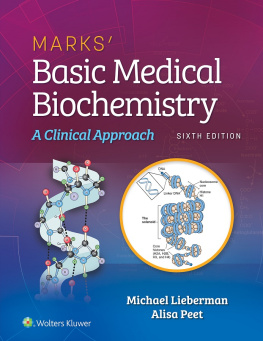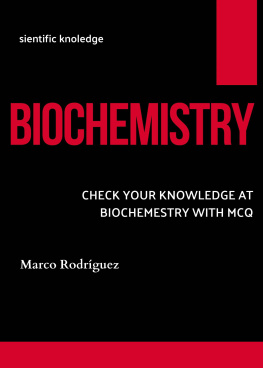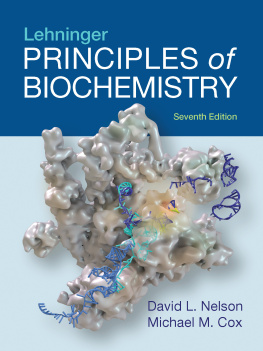Lippincotts
Illustrated Reviews:
Biochemistr
Sixth Edition
Denise R. Ferrier, PhD
Professor
Department of Biochemistry and Molecular Biology
Drexel University College of Medicine
Philadelphia, Pennsylvania

Health
Philadelphia Baltimore New York London
Buenos Aires Hong Kong Sydney Tokyo
Acquisitions Editor: Susan Rhyner
Product Manager: Angela Collins
Development Editor: Kelly Horvath
Marketing Manager: Joy Fisher-Williams
Production Manager: David Saltzberg
Art and Page Design: Debbie McQuade
Cover Design: Holly McLaughlin
Sixth Edition
Copyright 2014 (2011, 2008, 2005, 1994, 1987) Lippincott Williams & Wilkins, a Wolters Kluwer business
| 351 West Camden Street | Two Commerce Square; 2001 Market Street |
| Baltimore, MD 21201 | Philadelphia, PA 19103 |
Printed in China
All rights reserved. This book is protected by copyright. No part of this book may be reproduced or transmitted in any form or by any means, including as photocopies or scanned-in or other electronic copies, or utilized by any information storage and retrieval system without written permission from the copyright owner, except for brief quotations embodied in critical articles and reviews. Materials appearing in this book prepared by individuals as part of their official duties as U.S. government employees are not covered by the above-mentioned copyright. To request permission, please contact Lippincott Williams & Wilkins at Two Commerce Square, 2001 Market Street, Philadelphia, PA 19103, via email at (products and services).
9 8 7 6 5 4 3 2 1
Library of Congress Cataloging-in-Publication Data
Ferrier, Denise R.
Biochemistry / Denise R. Ferrier. -- 6th ed.
p. ; cm. -- (Lippincotts illustrated reviews)
Rev. ed. of: Biochemistry / Richard A. Harvey, Denise R. Ferrier. 5th ed. c2011.
Includes bibliographical references and index.
ISBN 978-1-4511-7562-2 (alk. paper)
I. Title. II. Series: Lippincotts illustrated reviews.
[DNLM: 1. Biochemistry--Examination Questions. QU 18.2]
612.39--dc23
2012025941
DISCLAIMER
Care has been taken to confirm the accuracy of the information presented and to describe generally accepted practices. However, the authors, editors, and publisher are not responsible for errors or omissions or for any consequences from application of the information in this book and make no warranty, expressed or implied, with respect to the currency, completeness, or accuracy of the contents of the publication. Application of this information in a particular situation remains the professional responsibility of the practitioner; the clinical treatments described and recommended may not be considered absolute and universal recommendations.
The authors, editors, and publisher have exerted every effort to ensure that drug selection and dosage set forth in this text are in accordance with the current recommendations and practice at the time of publication. However, in view of ongoing research, changes in government regulations, and the constant flow of information relating to drug therapy and drug reactions, the reader is urged to check the package insert for each drug for any change in indications and dosage and for added warnings and precautions. This is particularly important when the recommended agent is a new or infrequently employed drug.
Some drugs and medical devices presented in this publication have Food and Drug Administration (FDA) clearance for limited use in restricted research settings. It is the responsibility of the health care provider to ascertain the FDA status of each drug or device planned for use in their clinical practice.
The publishers have made every effort to trace the copyright holders for borrowed material. If they have inadvertently overlooked any, they will be pleased to make the necessary arrangements at the first opportunity.
To purchase additional copies of this book, call our customer service department at (800) 638-3030 or fax orders to (301) 223-2320. International customers should call (301) 223-2300.
Visit Lippincott Williams & Wilkins on the Internet: http://www.lww.com. Lippincott Williams & Wilkins customer service representatives are available from 8:30 am to 6:00 pm, EST.
Acknowledgments
I am grateful to my colleagues at Drexel University College of Medicine who generously shared their expertise to help make this book as accurate and as useful to medical students as possible. I am particularly appreciative of the many helpful comments of Dr. ke Rkaeus of the Karolinska Institute as they have enhanced the accuracy of this work. In addition, the author thanks Dr. Susan K. Fried and Dr. Richard B. Horenstein for their valuable contributions to the Obesity chapter in previous editions of this text. A special thank you to Dr. Alan Katz for his helpful comments on the clinical aspects of the cases in the Appendix. Ms. Barbara Engle was an invaluable sounding board throughout the process.
The editors and production staff of Lippincott Williams & Wilkins were an important source of encouragement. I particularly want to acknowledge the contributions of Susan Ryner, the Acquisitions Editor, and Angela Collins, the Managing Editor. Many thanks are due to Kelly Horvath, Development Editor, for her assistance in the final editing of this book. I also want to thank Deborah McQuade for her work in the assembly of the 6th edition.
This book is dedicated to my
husband John, whose loving
support made the task possible;
to my students, who have taught
me so much over the last 20
years; and to Richard Harvey and
the late Pamela Champe, who
helped me develop as an author.
Contents
(Use your scratch-off code provided in the front of this book for access to this and other free online resources on the point.)
UNIT I:
Protein Structure and Function
I. OVERVIEW
Proteins are the most abundant and functionally diverse molecules in living systems. Virtually every life process depends on this class of macromolecules. For example, enzymes and polypeptide hormones direct and regulate metabolism in the body, whereas contractile proteins in muscle permit movement. In bone, the protein collagen forms a framework for the deposition of calcium phosphate crystals, acting like the steel cables in reinforced concrete. In the bloodstream, proteins, such as hemoglobin and plasma albumin, shuttle molecules essential to life, whereas immunoglobulins fight infectious bacteria and viruses. In short, proteins display an incredible diversity of functions, yet all share the common structural feature of being linear polymers of amino acids. This chapter describes the properties of amino acids. explores how these simple building blocks are joined to form proteins that have unique three-dimensional structures, making them capable of performing specific biologic functions.
Figure 1.1 Structural features of amino acids (shown in their fully protonated form).










